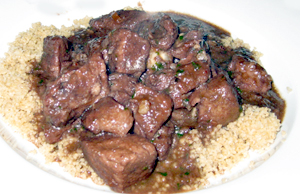Civet de Porc
Ingredients
- 2 lbs. pork shoulder butt
- 2 onion, thinly sliced
- 2 carrots, peeled & chopped
- 1 leek, white & pale green parts only, chopped
- 2 tomatoes
- 8 cloves garlic, peeled & crushed
- 1/2 lemon (optional)
- 8 black peppercorns.
- 1/2 tsp. dried thyme
- 2 bay leaves
- 1 bottle red wine
- 1 Tbsp. unsalted butter
- 1/4 cup + 1 Tbsp. olive oil
- 3 cups beef stock
- salt
- 1 slice bread, crust removed
- 6 almonds
- 4 hazelnuts
- 4 walnuts
- 1 Tbsp. pinenuts
- 1 oz bittersweet chocolate
- handful flat-leaf parsley leaves
Instructions
Cut the pork into 2" cubes. Put in a large, non-reactive bowl, with the onion, carrots, leek, tomatoes, garlic, lemon (if
using), peppercorns, thyme and bay leaves. Mix and add wine. Marinate in the refrigerator at least 24 hours, and up to 48.
Take the pork out of the marinade and put into a colander to drain, reserving the vegetables and the marinade. Dry the
pork with a clean towel.
Place the butter and 1/4 cup of olive oil in a dutch oven or another thick-bottomed pot, and melt over medium heat. Add
the pork and brown on all sides - you may need to do this in two batches. Take the pork off the pot, using a slotted spoon,
and place on paper towels to drain.
Meanwhile, strain the marinade, reserving the vegetables and the liquid. Discard the lemon half, if using.
Turn the heat under the pot where the pork had been browned to medium-high, and add the vegetables and herbs reserved from
the marinade. Saute them until the onions have softened and most of the liquid has evaporated, about 5 minutes. Remove from
the heat.
Meanwhile, put the liquid from the marinade in a small pot and bring to a boil. Cook over high heat until the marinade has
reduced by half, about 15 minutes.
Return the pork to the pot with the vegetables. Cover with the marinade and enough beef stock to cover the meat.
Bring the pot to a boil, then reduce heat and simmer uncovered until the pork is tender, about 1 hour. Turn off the heat.
Remove the pork from the pot using a slotted spoon and set aside. Strain the cooking liquid, and discard all the
vegetables/herbs. Return the pork and the liquid to the pot, season with salt, and then simmer covered over low heat until the
sauce is thick - about 10 to 15 minutes.
Meanwhile, fry the bread in the olive oil over medium-high heat, until crisp, about 2 minutes. Tear the bread and put the
bread, nuts, chocolate and parsley in a mini-chopper, process until you get a crumbly paste. Alternatively, use a mortar and
pestle.
Stir the nut mixture into the sauce and let simmer for 5-10 minutes. Transfer to a bowl and serve.
Civet de porc (or, more often, civet de senglar, which uses wild boar as its main ingredient), is a traditional and delicious Catalan dish. It showcases Catalonia's use of nuts both to provide texture and taste in its cuisine. The chocolate is probably a Mexican influence. Don't forgo the nut/chocolate mixture, as it ads an element of depth and richness to the sauce that you wouldn't otherwise get.
